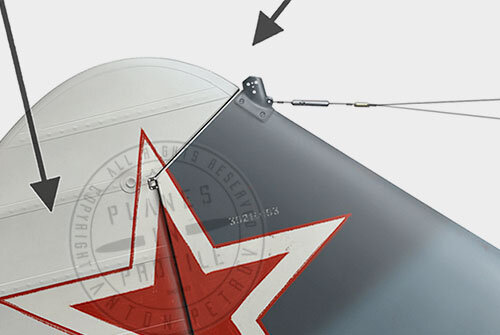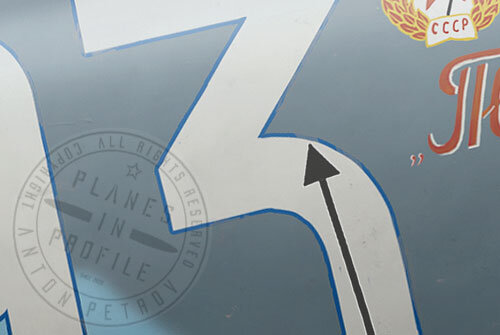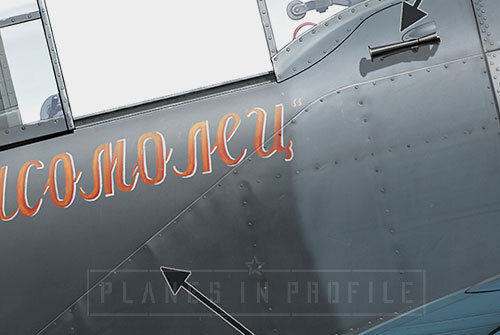Abramov’s White-(9?)3, “Penzenskiy Komsomolets”
Lavochkin, La-5FN (Late)
10-th (Red Bannered) GIAP , 1 GIAD, Baltic Fleet (KBF) VVS , circa late July 1944, presumably western Leningrad oblast’ (oblast’ = region), Russia.
Flown by the hero of the Soviet Union, Vladimir Fedorovich Abramov
Vladimir Abramov began the Great Patriotic War as an ordinary pilot, then in the fall of 1941 he became a commander of a flight, in September 1942 he became deputy squadron commander, and in November 1943, at age 22, he took command of a squadron. He flew the I-15bis, I-153 and Yak-7. While flying these machines, by the second half of 1943 he achieved 15 victories (2 personal and 13 shared).
By January 1944 the regiment was retrained to fly the La-5 airplanes [2] and from February ‘till the end of the war in May 1945, V. F. Abramov fought behind the controls of a La-5 airplane. While flying a La-5 he took part in operations to liberate the Leningrad region(Russia) as well as to drive the Germans out of Estonia, Latvia and Lithuania.
On March 19, 1944, Vladimir Fedorovich scored the first victory in his La-5FN fighter when he led 5 planes of his regiment against 27 enemy aircraft. In this battle, he personally shot down one enemy plane, a Ju-87 Stuka dive bomber. A couple of months later, in May 1944, Vladimir went on to score 4 more personal victories, including his last victory of the war, scored on the 26th of May. These 5 victories[3], all personal, were:
19.03.1944 1 Ju-87 западнее Нарва (west of Narva), Estonia
19.05.1944 2 FW-190 аэродром Кахула (airfield Kahula), Estonia
26.05.1944 1 Ju-87 юго-западнее Гакково (south-west Gakkovo), Russia
26.05.1944 1 FW-190 Усть-Нарва (Ust-Narva), Estonia
For his achievements in battles, on July 22, 1944 Abramov was awarded the Gold Star of the Hero of the Soviet Union (H.S.U). In the application for this award, his commanders noted his boundless devotion to the Motherland.
The photos of Abramov and “Penzenskiy Komsomolets” linked below might have been taken at that time or soon after, most likely (but unconfirmed) to celebrate him receiving the H.S.U award in July 1944, judging by the “Ceremonially” dressed Abramov with all of his medals displayed, including his Gold Star of H.S.U. It’s interesting to note that the airplane at this time is showing some wear and tare as is evidenced by the damage of the paintwork on the outline around the number ‘3’ as well as the dents in the heat protection panel. Though I was unable to find out when exactly Abramov received his “Penzenskiy Komsomolets” it makes logical sense to presume that he probably flew this plane for some time before the photos were taken.
His last, 600th battle sortie, Guards Captain V.F.Abramov performed on May 9th, 1945 near the same places where he once received his baptism of fire. This was not unusual for the aviators the Baltic Fleet’s Airforce, since, during the war years, the (KBF) VVS did not make those gigantic geographical movements which were so common to the majority of other units.
Vladimir Abramov ended the war with 20 aerial victories (7 personal and 13 shared), achieved during his 65 air battles, and 600 battle sorties [3]
Noteworthy Visual Characteristics
Please Note! No photo reference could be found for the left side of White-(9?)3, therefore the representation of this side of the plane (below) is hypothetical.
1) The white spinner and the white rudder were the markings of the Baltic Fleet VVS. White-93 was presumably marked with these marking, same as the other La-5FNs of the 10-th GIAP. An example of these can be seen HERE and HERE.
2) We can’t see the symbol representing the FN model of La-5 in the cropped photo reference, but it most likely appeared on this plane since this was common to most La-5FNs.
The symbol is a rhombus with the Cyrillic letters F and N inside it. These letters have to do with the improved engine which was given a designation M-82FN (or ASh-82FN). The letter ‘F’ is derived from the word ‘Forsirovanniy’ which means forced/boosted and refers to an improved supercharger (Same as in the La-5F ’s engine), and the letter ‘N’ is derived from ‘Neposredstvenniy’ which refers to the direct fuel injection system (as opposed to the one that used a carburetor in the previous models).
This photo shows a very good close-up of what the logo/symbol looks like, even though it’s on a different airplane https://aviaforum.ams3.cdn.digitaloceanspaces.com/data/attachment-files/2020/02/1489950_8f38b1e8d0f9a9034b786c98474180ff.jpg
3) Note the shape of the heat protection panels is that of the late type La-5FN.
4) Note the antena wires arrangement marked by ‘4a’. Such arrangement is rarely seen on any other Lavochkins. The main antena mast is missing and the wires look like they might have been attached to the base of the small antena mast on the vertical stabilizer, marked by ‘4b’. As per the image below. This suggests that the actual ‘antena mast’ on the v.stabilizer might have been absent.
5) An image of the ‘Guards’ badge.
6) An image of the ‘Order of the Red Banner’ medal.
7) Note the location of a Venturi Tube just in front of the canopy on the starboard side of the plane. This is quite unusual for the La-5s. Almost all the La-5s I have seen (including F and FN) are absent of the Venturi tube in this location.
8) The first digit of the tactical number is mostly cut off in the photo reference, so we can’t see it. But if we extrapolate the part of the first digit that is visible in the photo, the rest of it seems to fit the shape of number "9" best. However there is also a very good chance that it might have been number ‘2’ instead of ‘9’.
9) Number 9 indicates areas which show signs of ‘ageing’ as seen in the photo reference, indicating that the plane was not new at the time the photos were taken. This rules out the idea that White- 93 was a new plane gifted to Abramov around the time the photos were taken.
’9a’ points to an area where it appears that the outline around the number 3 has been chipped off.
’9b’ points to the dents in the heat protection panel visible in the photo reference. This area also shows soot and dirt stuck in the rivet holes, while the rest of the plane appears to be relatively clean. This suggests that the airplane might have been washed for the photo session with Abramov. If this was the case then the exhaust panels marked by ‘9c’ might have been relatively clean of exhaust stains.
10) “Пензенский Комсомолец” (Penzenskiy Komsomolets) translates to ‘Penza’s Komsomolets’. Komsomolets is a young person(male) who is a member of the All-Union Leninist Young Communist League)’.
This is an inscription which appeared on many of the machines built for the Red Army with the money collected by the people of the city of Penza.
The people of Penza have collected and donated 129 million roubles to the Red Army fund during the war. These substantial contributions were enough to build one submarine, two torpedo boats named ‘Penza’s Komsomolets’ and ‘Penza’s Pioner’, a column of tanks named ‘Penza’s Komsomolets’ as well as 39 aviasquadrons. [1]
Abramov’s White-93 is most likely one of the airplanes built with these funds. Abramov is a native of the Penza region, having been born in the town of Kuznetsk, which is undoubtedly a part of the reason why he was assigned a plane with such inscription.
The inscription appears to have been brush painted, as opposed to have been spray painted using a stencil. For this reason, it is probable that it only appeared on one side of the airplane.
Also, Note the absence of the large star on the fuselage in this area.
11) The cowl bands seem to have been painted on the majority of La-5FNs of the 10-th GIAP which you can view on ava.org.ru, or by clicking HERE and HERE for example. The planes which seem to show these strips as bare metal probably had the paint chipped off them over time exposing the metal, as opposed to have been bare metal (unpainted) from the start. Based on this evidence and reasoning I have concluded that White-93’s cowl bands were most likely painted with the paint beginning to chip off slightly.
12) The camouflage pattern on the part of the plane visible in the photo reference appears to be consistent with the standard Grey/Grey camouflage pattern introduced in 1943. Therefore it is safe to presume that the top surfaces were most likely painted in accordance with this camouflage.
Here are a few closeup images to help illustrate the points above. Full set of closeup images is On Patreon
FOOTNOTES
The info in the ‘A Bit of History’ section is collected from various sources, including:
peoples.ru https://www.peoples.ru/military/hero/vladimir_abramov/
soviet-aces-1936-53.ru http://www.soviet-aces-1936-53.ru/abc/a/abramov_vf.htm
[1] This info is taken from https://news.rambler.ru/other/44138174-voyna-penzenskaya-oblast-1941-1945-gg/
[2] This info is according to ava.ru. http://ava.org.ru/iap/10gm.htm
[3] The list of victories and Abramov’s achievements by the end of the war were taken from Mikhail Bykov’s book called ‘Все Асы Сталина’ (All of Stalin’s Aces), page 239. Youza-press, 2014.
LINKS TO THE REFERENCE Images and videos
All the work presented on this is page is subject to updates and revisions in the light of new information which might present itself. If you have any new information relevant to this page or disagree with anything that's presented here, then please feel free to contact me through the Planes in Profile Facebook page. Thanks:)







